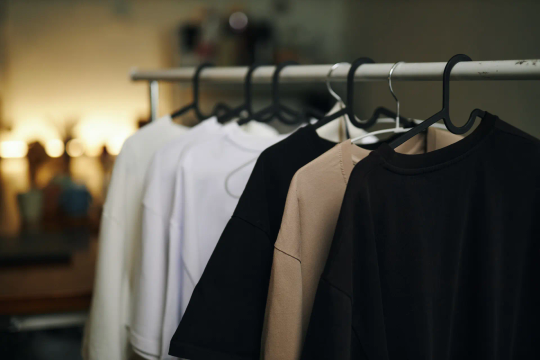What Garment Should I Choose for Custom Apparel?
In this guide, we’ll break down the essentials to help you order with confidence.
Published 5/30/25

Technique Definitions
Whether you're a small business owner, a DIY enthusiast, or a professional printer, understanding how to match your fabric to your printing method is the key to achieving vibrant, durable results.
Let’s do a quick review of the primary print methods:
Screen Printing: A traditional method where ink is pushed through a mesh stencil onto the fabric. It’s ideal for bold, solid designs and large production runs.
Direct-to-Film (DTF) Printing: A hybrid print method where designs are printed onto a special film, coated with adhesive powder, and heat-pressed onto the fabric. Delivers vibrant, full-color results on nearly any material, making it a flexible option for detailed artwork and short runs.
Direct-to-Garment (DTG) Printing: A digital printing method where ink is sprayed directly onto the fabric and absorbed into the fibers. Best for soft, high-resolution prints on cotton garments. Ideal for small runs, one-offs, or designs with lots of color and fine detail.
Sublimation Printing: A heat-transfer process where dye turns into gas and bonds with polyester fabric at the molecular level. Produces vibrant, long-lasting, full-color designs with no ink texture. Perfect for all-over prints on white or light-colored synthetic garments.
The garment you choose will interact differently with each method, so let’s dive into all of the factors to consider.
Key Factors in Garment Selection
Fabric Composition
Cotton: A top choice for both screen printing and DTG. Cotton absorbs ink well, making it ideal for screen printing’s bold coverage and DTG’s soft, detailed prints.
Polyester: Excellent for sublimation and DTF. Sublimation requires polyester to bond with the dye, while DTF adheres well to both polyester and blends.
Blends: Cotton-poly blends offer flexibility. DTG can work on high-cotton blends, DTF works well on most, and sublimation only works if polyester is dominant.
Other Fabrics: Linen, hemp, and specialty synthetics may require testing. DTF often performs best on tricky fabrics, while DTG and sublimation are more limited in material compatibility.
Weave and Texture
Smooth fabrics: Ring-spun cotton and fine jersey knits work well with all print methods. DTG, DTF, and sublimation all benefit from an even surface for clarity and detail.
Textured fabrics: Canvas, fleece, or slub textures may not suit DTG or sublimation. DTF handles texture better, while screen printing can succeed with adjustments.
Durability and Wear
For rugged, long-term use (e.g., workwear), screen printing and embroidery offer max durability. DTF is a close second. DTG is best for fashion and low-abrasion uses. Sublimation offers unmatched durability, but only on polyester.
Fabric Weight
Lightweight (4–6 oz): Great for DTG and DTF. Both apply ink with a soft hand. Sublimation is also a good match for lightweight synthetic tees. Screen printing may require finesse to avoid ink bleed.
Medium Weight (6–8 oz): Works well across the board: ideal for screen printing, DTF, and DTG. Sublimation applies only if the fabric is synthetic.
Heavyweight (10+ oz): Best for screen printing. DTF and DTG can work but may feel heavy or stiff depending on the size of the design. Sublimation is rarely used on heavyweight garments.
Color
Light colors: White and pastels are great for all methods. Sublimation is limited to light-colored garments only. DTG and DTF thrive here for vibrant detail.
Dark colors: Screen printing and DTF handle dark garments well (both use white underbase). DTG supports dark fabrics but requires pretreatment. Sublimation does not work on dark colors.
Summary
Best for Screen Printing
100% cotton or high-cotton blend t-shirts (medium weight)
Hoodies or sweatshirts for bold, long-lasting designs
Light-colored fabrics for simpler setups
Best for Direct-to-Film (DTF) Printing
Polyester or blended activewear for colorful, intricate designs
Lightweight tees or fashion garments for a soft finish
Dark fabrics needing detailed, multi-color prints
Best for Direct-to-Garment (DTG) Printing
100% cotton tees or fashion blanks with smooth weaves
Small runs, personalized prints, and photo-realistic designs
Light or dark fabrics with appropriate pretreatment
Best for Sublimation Printing
Polyester shirts, jerseys, and performance gear
White/light garments only
Edge-to-edge, high-detail designs or patterns
Conclusion
Choosing the right garment for screen printing, direct-to-film, DTG, or sublimation doesn’t have to be overwhelming. By considering fabric type, weight, texture, color, and your project’s goals, you can zero in on the method that will deliver the best results.
Still unsure? Let us help. Whether you’re producing bulk team wear or a one-off art piece, we’ll guide you toward the best garment and print technique for the job.
Whether you’re crafting a one-off masterpiece or a bulk order, we can help you bring your vision to life.
Let's get started!
Once we get the details about your project, our team will go to work developing a plan and work with you to finalize your design artwork.